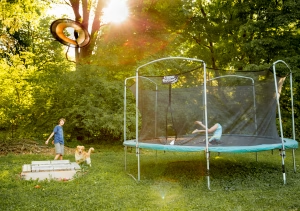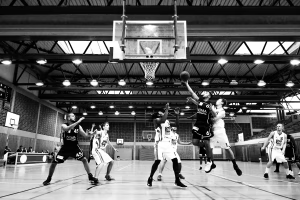Back Pain
Throwing my Back Out! And Self-Treatment
 I’ve arrived, folks. I’ve made it! I am finally “threw-my-back-out-doing-nothing” years old.
I’ve arrived, folks. I’ve made it! I am finally “threw-my-back-out-doing-nothing” years old.
One morning last week, I was doing my Qi Gong practice, followed by stretching. I got up off the floor, and I felt my familiar old friend—my right sacroiliac joint—a sprain-like, nerve sensation coupled with soreness, say hello for the first time in years.
In fairness, the stage had been set leading up to this relatively non-expenditure of motion. I’d spent the week before doing an inordinate amount of housework, hosting family staying with us, much more cooking and cleaning, a bit more indulging, not to mention a home’s worth of laundry after my daughter’s Lice sequel, so my body was spent. On the day before I jumped as high as I could on our trampoline and wrestled maniacally with 4-year-olds.
I spent the next morning in pain, obsessively trying to stretch, but to no avail. It was apparently too inflamed, needed first to set in before it could heal, the way it is difficult to resolve a virus in its first 12 hours—that is before it shows itself for what kind of virus it is. By afternoon I could barely walk (unfortunately in parenthood rest is rarely an option). I surely couldn’t lift anything, and wondered if I’d make it to work the next day!
- SIMPLICITY & REPETITION: I decided to minimize, to consolidate my rehabilitative routine to just a few reliable stretches, which is important in my opinion, then did them constantly. Some physical therapists make the mistake of assigning 8 or 9 daily exercises, most of which might be beneficial, but if one or two are potentially aggravating, they might keep people on the hamster wheel of suffering, not realizing they could be doing less and getting better.
- HERBS: Once in a while we are forced off of our soap boxes and bow in humility in front of that which we resist. I prescribed myself a non-holistic formula—not individualized to my unique pattern—but one simply for inflammation in the low back and lower body. Well worth it short-term, though in fact I did suffer a side effect as a result. While excitatory/warm-natured eucommia bark probably helped my back, it did impact my quality of sleep that night. I cooked it in conjunction with pearl barley, phellodendron bark, and other blood movers to promote circulation in the lower portion of the body, then drank it while my wife warmed up a heating pad for me.
- HEAT: As we say in Chinese medicine: “Ice is for dead people”—dead bodies to be exact, but most injuries are not ones of inflammation to the degree of compartment syndrome, which merits ice. Most are minor, protective inflammations surrounded by tight, hypertonic muscles and ligaments that need relaxation, which heat provides.
- ACUPUNCTURE: While lying atop my heating pad, I obviously could not needle my own lower back, but I could use “distal points” that connect the spine, ligaments, and erector spinae muscles. I used “Small Intestine 3,” located next to the pinky joint, to treat the spine, “Spirit Bone,” located at the junction of the first and second metacarpals, for its endogenous opioid-releasing effects and connection with the low back’s complementary (lung) vessel; finally “Triple Warmer 9,” atop the forearm near the elbow, also to send blood to its paired vessel. I left the needles in for thirty minutes, basically the duration of a TV show we watched (Wednesday—not thus far recommending), and when I got up to go to bed I was about 25% better. When I woke up the next morning I was 75% better, still having not taken one single, solitary NSAID. No judgement for those that need painkillers, but in my opinion, their side effects should be respected enough to reserve them for times of actual need—pain in times when we need to be active, as opposed to discomfort in times where we can relax.
I should continue to get acupuncture from someone else for this as well. Also, I must do my daily stretches, gradually incorporating more every few days, and probably call it a year on my trampoline wrestling career. I share this story not to brag—though it’s nice to brag—but to reiterate the value of constant and appropriate physical movement and attention towards our ailments. I went from being unable to walk to a full commute and pain-free workday overnight!
Tyrese Haliburton’s Achilles & Voice!

As a Buddhist I feel guilty about the mixed emotions I had as a (resentful) Knicks fan when Tyrese Haliburton went down in Game 7 after re-injuring his torn calf muscle and probably his Achilles tendon, sidelining the Pacers’ star for the rest of the game. I’m sure once that happened the odds in Vegas went heavily in favor of OKC.
As a Chinese medicine clinician, I couldn’t help but wonder, in the interim since the original injury how much his trainers had iced it to “bring down inflammation” even though Chinese Medicine and Dr. Gabe Mirkin, the originator of the R.I.C.E. protocol, recommend against it due to its vasoconstrictive mechanism.
Ice should be limited to stage 1 of an injury, only if there is some local redness, and even then Chinese medicine has something better to offer, San Huang San plaster, for its extensively studied anti-inflammatory, analgesic, and blood circulating effects.
The vessel that runs from the Achilles heel up to the calf and in fact the entire back is named the “Foot Tai Yang,” or urinary bladder, which logically acquires its nutrients and blood via its complementary vessel, the “Hand Tai Yin,” the lung vessel.
I recalled a story from last year that Haliburton has an odd but presumptively harmless condition where his voice changes inflection frequently and without apparent cause or warning. He laughed about it after several press conferences, saying he’d never realized he had this condition, but noticed exactly what others had while listening to himself speak.
Our voice of course is dependent on proper pulmonary function, which is why everyone immediately understands what someone means by “smoker’s voice.” Smoking dries the fluids, which might also explain why cigarette smokers are three times more prone to bladder cancer.
The ancient Chinese understood this connection. For all their brilliance at what they do, it is unlikely that modern sports medicine physicians do. Their lens is to isolate and treat, whereas ours’ is to understand every piece of the puzzle, no matter how seemingly disconnected.
In the article I read on Haliburton, a voice specialist medical doctor cited the fact that athletes do have to use their voice quite a lot on the court when communicating, but probably not nearly as much as performers or teachers or several other professions, right? I don’t think athletes are generally more prone to dysphonia. Also, basketball players may be more prone to issues with Achilles tendons, ankles, and knees, but it is notable that the remaining starting nine players in the Finals were playing the same game on the same floors at the same pace, and did not tear their calves. Only the guy with the history of dysphonia did—in my opinion due to the physiological connection between Foot Tai Yang and Hand Tai Yin. So the next time you have shoulder pain, knee pain, or any pain, by all means go to the doctor and get assessed—then go to a (good) Chinese medicine clinician to understand what’s happening beneath the surface.
Congrats OKC!
Acupuncture for Chronic Back Pain

A Harris Poll released earlier this year found that approximately three out of ten U.S. adults currently suffer from chronic low back pain. To put it another way, that’s an estimated 72.3 million people! Common treatments usually include prescription medications which bring their own complications and side effects into the picture. If you are looking for a drug-free alternative to your back pain, acupuncture could be the solution you have been searching for. continue reading
Treating Sciatica Pain with Acupuncture

Anyone who has suffered from sciatic nerve pain can tell you it can be a very debilitating condition. It is typically caused by an impingement of the sciatic nerve in the lower back but the pain is actually felt radiating down the leg and in the buttock. There are several potential causes of sciatic pain including:
- Degenerative disc disease
- Lumbar spinal stenosis
- Spondylolisthesis
- Pregnancy
- Herniated lumbar disc (also known as a slipped disc)
Acupuncture is one of the most gentle and effective treatment options. Traditional medicine may prescribe medication to deal with the pain caused by sciatica but acupuncture is a drug-free option that treats the issue and not just the symptom. continue reading


